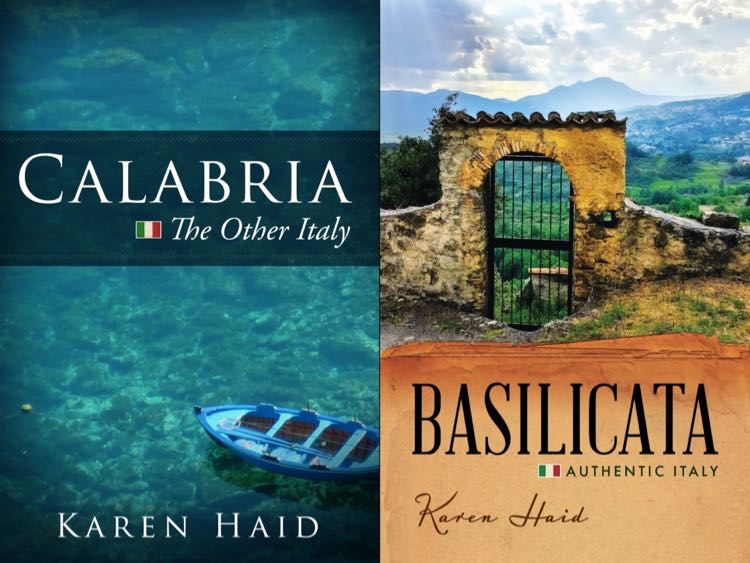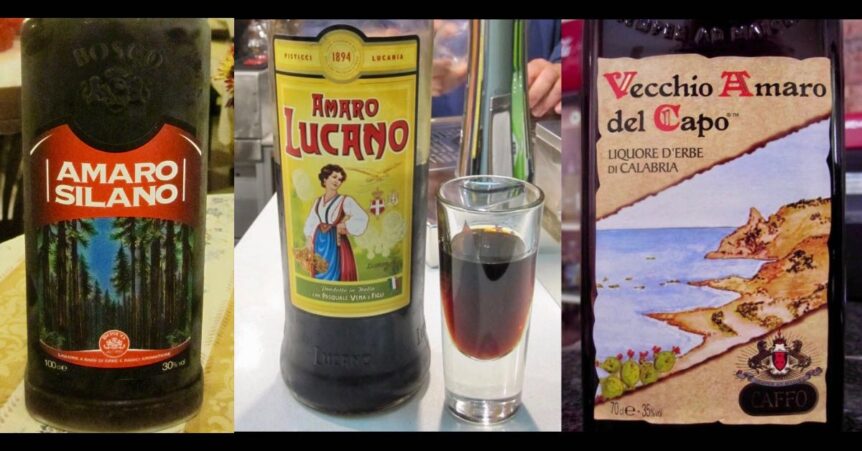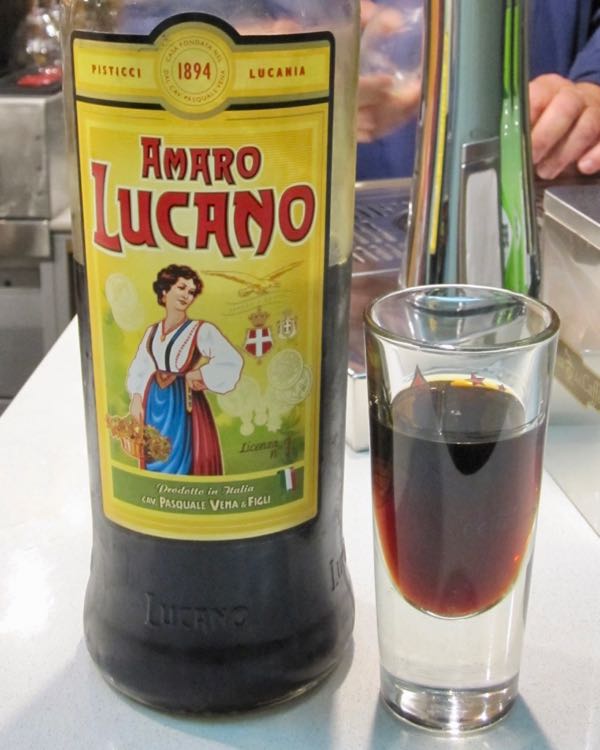At the end of a copious Italian meal, you will invariably be offered something to drink, a digestivo, such as a liquore, possibly an amaro, or a brandy, perhaps a grappa… These beverages with a rather high alcoholic content aid in digestion, thus the name, digestif. Most have a strong connection with their place of origin, such as the Vecchio Amaro del Capo, the Amaro Lucano, the Amaro Silano and others that I have enjoyed throughout Italy. Here are a few amari (bitters) with names and labels that reflect their ties to Calabria and Basilicata in South Italy.
AMARO = BITTERS
But before I wax poetic on the most popular amaro of South Italy, I will address the question, “What is an amaro?” Readers not sure of the meaning may, understandably, be a bit apprehensive of the English word “bitters.” Word associations like “bitter pill” and “bitter vegetables” are surely not recommendations. But then there’s “bitter chocolate” and we’re entering another realm entirely. (Although, I do love my bitter greens.)
Older readers may remember a great aunt saying something like, “taking my bitters” as she poured herself a thimbleful of darkish liquid from a dusty bottle stored under the kitchen sink. Traditionally, an alcoholic concoction prepared with botanical matter, bitters were a form of herbal medicine, taken to aid digestion. Depending on the formula, the taste can range from bitter to bittersweet.
In the European Union, an amaro must be flavored with natural substances, such as herbs and fruit, and have a minimum alcohol level of 15% by volume, although on average the alcoholic content is double that.
VECCHIO AMARO DEL CAPO
The best known amaro from Calabria is the Vecchio Amaro del Capo, the name of which refers to Capo Vaticano, pictured on the bottle’s label. The location is gorgeous, along the “Coast of the Gods” on the Tyrrhenian Sea, just south of well-known Tropea.
This bitter is made by Gruppo Caffo 1915 in nearby Limbadi, a town on the southern side of Mount Poro, Province of Vibo Valentia. A result of many years of experience and research with the area’s traditional recipes, the Vecchio Amaro del Capo was introduced in the 1970s and has since gained a national and international reputation.
The Amaro del Capo has a sweet flavor with a rich aftertaste. The recipe blends twenty-nine herbs, flowers, fruits and roots from the area, including mandarin, sweet and sour oranges, anise, chamomile, juniper, licorice, mint and hyssop, and has an alcohol content of 35%. The digestif is quite pleasant and as mentioned above, can be the type “taken” by older women who claim not to drink.
For best flavor, the Vecchio Amaro del Capo should be consumed very, very cold. Bitter cold. The company recommends -20 °C, which is -4 °F. The glasses should also be frozen. Honestly, if someone places a lukewarm glass of Amaro del Capo in front of me, I send it back.
AMARO LUCANO
The lucano holding this bottle of Amaro Lucano was anything but bitter! “Lucano,” by the way, refers to an ancient people who settled in the area of what is today Basilicata, and is the word used for its inhabitants and, as an adjective, to describe the region itself. (Details in my book Basilicata: Authentic Italy.) A lucana wearing the traditional clothing of Pisticci, Basilicata graces the bottle’s label.
The Amaro Lucano is Basilicata’s best-known amaro and can be found throughout Italy. The bitters’ secret recipe was created in 1894 in the back room of a cookie factory in Pisticci, an historic town built on three hills and surrounded by a mix of badlands and cultivated areas with a territory that extends all the way to the Ionian Sea in the Province of Matera. Back in the day, the King of the House of Savoy liked the Amaro Lucano so much that he honored Pasquale Vena, its creator, with the title Cavaliere. Production was moved to the newer neighborhood of Pisticci Scalo in the 1960s.
The Amaro Lucano is a smooth blend of over thirty herbs, leans towards the sweet side of bitter and contains 28% alcohol by volume. It can be enjoyed straight, with an ice cube and/or with a twist of orange peel.
AMARO SILANO
The Amaro Silano has the distinction of being the oldest amaro in Calabria. Still faithful to the original recipe developed by Raffaele Bosco in 1864, these bitters continue to be produced by Bosco Liquori of Cosenza. Apropos that the founder’s name Bosco means woods, and that the Silano, or the Sila Mountains are renowned for their forests, as well as extraordinarily clean air. Historically, the amaro’s label depicted the majestic pine trees of the Sila.
For the company’s 150th anniversary, Amaro Silano took on a new look, and today’s label features a wolf, a symbol of the Sila, with the invitation to “Bevi fuori dal branco” or drink outside the pack. Be the lone wolf and choose the full-bodied, aromatic bitter, made from local herbs through a slow maceration process, that when released evoke the pure, natural environment of the Sila Mountains themselves.
With 30% alcohol by volume, the Amaro Silano boasts an intense flavor of herbs and caramel, best appreciated when served out of the freezer, and also good with a twist of orange.
AMARO MARATEA, AMARO SCILLA, AMARO DEI SASSI
It seems every time I turn around lately, I’m being tempted to taste another amaro. It’s the bitter truth. Each recipe has a personal touch, identifiable with local herbs and perhaps even a sea breeze.
On Basilicata’s very small coastline along the Tyrrhenian Sea sandwiched between Campania and Calabria, the town of Maratea presents its own formula created by the Farmacia dei Sani, an old recipe featuring herbs from the area, green walnut, sour orange, wild fennel and mint. The Amaro Maratea has a lush, dramatic shoreline to show off on its bottle, too.
Further down the coast along the Strait of Messina and almost to the tip of Calabria, Scilla, a beautiful old fishing village that has become a tourist destination, has its own bitters. The Amaro Scilla has its roots in popular festivals of the early 1900s and today’s recipe is based on citrus, flowers and bitter herbs from the coastal area all the way up to the Aspromonte Mountains just behind. Scilla’s oldtown with its famous castle-topped outcropping adorns the label.
Heading back northward to Basilicata, over to the Ionian side and a bit inland, I was once offered a glass of the Amaro dei Sassi after a meal in Matera, the city world-renowned for its historic dwellings dug out of stone. The bottle featured an outline of the Sassi, and the “ricetta speciale” (special recipe) was bitterly pleasant and served in a wineglass with ice.
WOULD YOU LIKE AN AMARO?
The Vecchio Amaro del Capo, the Amaro Lucano, the Amaro Silano and those of Maratea, Scilla, Matera and many others are just the tip of the bitters iceberg when asked after a meal: Gradisce un amaro? Una grappa? Un digestivo fatto in casa? Hold on, what was that last question? Would I like a digestif made in-house? Sì, grazie, accept that unmarked bottle without hesitation!
P.S. Some of the newer bitters garnering praise include Amaro Jefferson from Montalto Uffugo, Amaro Rupes from Rocella Jonica and Képhas, a digestivo grecanico from Bova, the Greek area of Calabria, but as bitterly as I would have liked to include them, they will be for a future blogpost.
Don’t want to wait until after a meal to sample an amaro? Try one in an Italian bar!
Or try one with me on a small-group tour of the “other Italies.” See the full itineraries on my Calabria tour page and Basilicata tour page.
Check out my books “recommended to readers who appreciate all things Italian” by the Library Journal.
Follow me on social media: Basilicata Facebook page, Calabria: The Other Italy’s Facebook page, Karen’s Instagram and Karen’s Twitter for beautiful pictures and information.
Sign up below to receive the next blog post directly to your email for free.











Comments 10
Great blog
More please
Author
Ha, ha – glad you liked it! I’ll do my best, and don’t forget to browse through past posts. 128 to date, which will keep you reading for a while.
We made Katie Parla’s amaro recipe from Food of the Italian South cookbook recently. After steeping and adding the sugar syrup, we had our first taste the other night–delicious!
Author
And a great time to make your own while waiting for that next visit to Italy!
I’ve never been a big fan of the Amaro but do love the Bergamot creme liquor and the chocolate Erotika liquor from Calabria – amazing!
Author
I, too, enjoy bergamot liquors, and the cream adds a nice silky quality. The Erotika is one of Bosco Liquori’s (of the Amaro Silano) many fine products.
I had a grappa when I was in Italy and it wasn’t my cup of tea. Been a fan of Angostura bitters for awhile, but I’m excited to try these other types especially on their own rather than as part of a cocktail mix.
Author
I think grappa may fall into the “acquired taste” category for many people, but there are definitely those that go down smoother than others. Mixologists are coming up with all sorts of new combinations, but with so many herbs that go into these bitters, as you say, they warrant a sampling in their pure form.
Ciao Karen-great Amaro tour! My family’s usual amaro is Amaro Lucano, but since we haven’t been to Italia for 20 months now, supply has dried up! It is sometimes available in Toronto, but not in Vancouver. Even our precious gifted bottle of Amaro del Capo is gone-although I’m keeping the bottle. Now we have had to resort to drinking Montenegro. Since we can now get 70% grain alcohol and my Limoncello came out great-i’m going to try making my own. I just have to find ingredients like juniper berries, gentian bark, etc. I’ll let you know how it comes out! Did you know the Carabinieri have their own amaro? it’s called Amaro dei Carabinieri and it is only available to them. Salute, Cristina
Author
You could create your own Amaro Vancouver or better yet Amaro Cristina! I hadn’t ever heard of the Amaro del Carabiniere, but I just googled it and they have their own paragraph on Italian Wikipedia – 63 herbs!